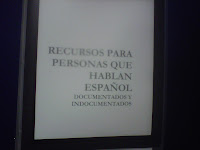Bronx Community Solutions Creates Resource Manual for Spanish Speaking Clients
By Anjelica Raygoza, Mental Health Case Manager
Soon after my arrival to Bronx Community Solutions I participated in conversations with other staff members regarding the particular needs of the Spanish-speaking clients that we service. In particular, Moises Reyes and Ramon Semorile, Coordinator of Community Service and Crew Supervisor, respectively, were consistently gathering information from clients about the services that are of predominant importance to them. The dialogues that took place between clients and staff during the intake process, in the field during community service and in Spanish-language social service classes were the spring board for the creation of the Spanish-language resource directory.
The idea was to produce a directory for in-house use that was meticulously tailored to the needs of our Spanish-speaking and indigent population. That is, the attempt was to intentionally divert from developing a “one-size fits all” directory. Most importantly, it was written in the Spanish-language to facilitate the clients’ access to it. It was created to include services that accommodated for economic status, language barriers, immigration status, demographic locations and other pertinent factors that increase the probability that clients will seek out the services that support a higher quality of life.
Titled Recursos Para Personas Que Hablan Español, Documentados y Indocumentados (Resources for Spanish-Speaking Individuals, Documented and Undocumented), the directory includes services in the domains of medical care, mental health services, drug treatment, legal help with immigration, job training/education classes, amongst others; details of the service agency such as location and payment options are included. Additionally, it includes detailed information regarding their rights to public/community services, accessing their criminal record and sealing cases. This was added in an effort to empower clients to take more control of factors that affect their daily lives by providing them with information that is often obscure and incorrect when received “in the streets.”
While it may take more than a Spanish-language resource directory to encourage clients to access services, a parsimoniously written manual, free of fluff and complicating details, is a concrete tool that clients can have in their path to creating lives that are healthy and fruitful.

Comments